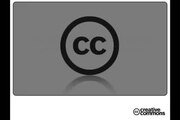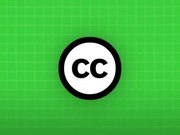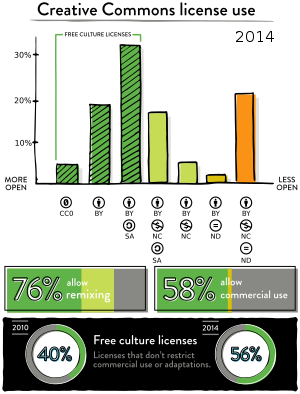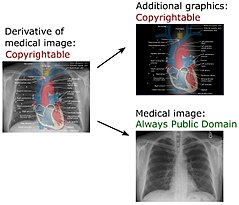CTVSD3/OER and Creative commons/Creative Commons
A Creative Commons (CC) license is one of several public copyright licenses that enable the free distribution of an otherwise copyrighted "work".[note 1] A CC license is used when an author wants to give other people the right to share, use, and build upon a work that they (the author) have created. CC provides an author flexibility (for example, they might choose to allow only non-commercial uses of a given work) and protects the people who use or redistribute an author's work from concerns of copyright infringement as long as they abide by the conditions that are specified in the license by which the author distributes the work.[1][2][3][4][5]
There are several types of Creative Commons license. The licenses differ by several combinations that condition the terms of distribution. They were initially released on December 16, 2002 by Creative Commons, a U.S. non-profit corporation founded in 2001. There have also been five versions of the suite of licenses, numbered 1.0 through 4.0.[6] Released in November 2013, the 4.0 license suite is the most current.
In October 2014, the Open Knowledge Foundation approved the Creative Commons CC BY, CC BY-SA and CC0 licenses as conformant with the "Open Definition" for content and data.[7][8][9]
Contents
Applicable works
Work licensed under a Creative Commons license is governed by applicable copyright law.[10] This allows Creative Commons licenses to be applied to all work falling under copyright, including: books, plays, movies, music, articles, photographs, blogs, and websites.
Types of license
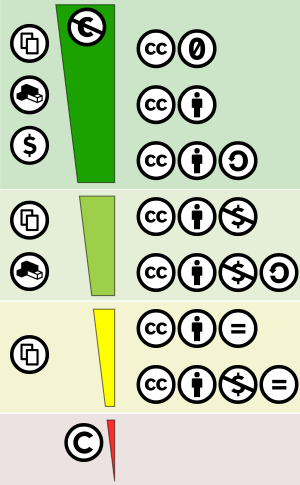 Creative commons license spectrum between public domain (top) and all rights reserved (bottom). Left side indicates the use-cases allowed, right side the license components. The dark green area indicates Free Cultural Works compatible licenses, the two green areas compatibility with the Remix culture. |
Four rights
The CC licenses all grant "baseline rights", such as the right to distribute the copyrighted work worldwide for non-commercial purposes and without modification.[11] In addition, different versions of license prescribe different rights, as shown in this table:[12]
| Icon | Right | Description |
|---|---|---|

|
Attribution (BY) | Licensees may copy, distribute, display and perform the work and make derivative works and remixes based on it only if they give the author or licensor the credits (attribution) in the manner specified by these. Since version 2.0, all Creative Commons licenses require attribution to the creator and include the BY element. |

|
Share-alike (SA) | Licensees may distribute derivative works only under a license identical ("not more restrictive") to the license that governs the original work. (See also copyleft.) Without share-alike, derivative works might be sublicensed with compatible but more restrictive license clauses, e.g. CC BY to CC BY-NC.) |

|
Non-commercial (NC) | Licensees may copy, distribute, display, and perform the work and make derivative works and remixes based on it only for non-commercial purposes. |

|
No Derivative Works (ND) | Licensees may copy, distribute, display and perform only verbatim copies of the work, not derivative works and remixes based on it. Since version 4.0, derivative works are allowed but must not be shared. |
The last two clauses are not free content licenses, according to definitions such as DFSG or the Free Software Foundation's standards, and cannot be used in contexts that require these freedoms, such as Wikipedia. For software, Creative Commons includes three free licenses created by other institutions: the BSD License, the GNU LGPL, and the GNU GPL.[13]
Mixing and matching these conditions produces sixteen possible combinations, of which eleven are valid Creative Commons licenses and five are not. Of the five invalid combinations, four include both the "nd" and "sa" clauses, which are mutually exclusive; and one includes none of the clauses. Of the eleven valid combinations, the five that lack the "by" clause have been retired because 98% of licensors requested attribution, though they do remain available for reference on the website.[14][15][16] This leaves six regularly used licenses plus the CC0 public domain declaration:
Seven regularly used licenses
The seven licenses in most frequent use are shown in the following table. Among them, those accepted by the Wikimedia Foundation – the public domain dedication and two attribution (BY and BY-SA) licenses – allow the sharing and remixing (creating derivative works), including for commercial use, so long as attribution is given.[16][17][18]
| Icon | Description | Shortening | Attribution Required | Allows Remix culture | Allows commercial use | Allows Free Cultural Works | Meets the OKF 'Open Definition' |
|---|---|---|---|---|---|---|---|
| |
Freeing content globally without restrictions | CC0 | Template:Yes | Template:Yes | Template:Yes | Template:Yes | Template:Yes |
| |
Attribution alone | BY | Template:Maybe | Template:Yes | Template:Yes | Template:Yes | Template:Yes |
| |
Attribution + ShareAlike | BY-SA | Template:Maybe | Template:Yes | Template:Yes | Template:Yes | Template:Yes |
| |
Attribution + Noncommercial | BY-NC | Template:Maybe | Template:Yes | Template:No | Template:No | Template:No |
| |
Attribution + Noncommercial + ShareAlike | BY-NC-SA | Template:Maybe | Template:Yes | Template:No | Template:No | Template:No |
| |
Attribution + NoDerivatives | BY-ND | Template:Maybe | Template:No | Template:Yes | Template:No | Template:No |
| |
Attribution + Noncommercial + NoDerivatives | BY-NC-ND | Template:Maybe | Template:No | Template:No | Template:No | Template:No |
Version 4.0 and international use
The original non-localized Creative Commons licenses were written with the U.S. legal system in mind; therefore, the wording may be incompatible with local legislation in other jurisdictions, rendering the licenses unenforceable there. To address this issue, Creative Commons asked its affiliates to translate the various licenses to reflect local laws in a process called "porting."[19] As of July 2011, Creative Commons licenses have been ported to over 50 jurisdictions worldwide.[20]
The latest version 4.0 of the Creative Commons licenses, released on November 25, 2013, are generic licenses that are applicable to most jurisdictions and do not usually require ports.[21][22][23][24] No new ports have been implemented in version 4.0 of the license.[25] Version 4.0 discourages using ported versions and instead acts as a single global license.[26]
Rights and obligations
Attribution
Since 2004, all current licenses other than the CC0 variant require attribution of the original author, as signified by the BY component (as in the preposition "by").[15] The attribution must be given to "the best of [one's] ability using the information available".[27] Creative Commons suggests the mnemonic "TASL:" title -- author -- source [web link] -- [CC] licence.
Generally this implies the following:
- Include any copyright notices (if applicable). If the work itself contains any copyright notices placed there by the copyright holder, those notices must be left intact, or reproduced in a way that is reasonable to the medium in which the work is being re-published.
- Cite the author's name, screen name, or user ID, etc. If the work is being published on the Internet, it is nice to link that name to the person's profile page, if such a page exists.
- Cite the work's title or name (if applicable), if such a thing exists. If the work is being published on the Internet, it is nice to link the name or title directly to the original work.
- Cite the specific CC license the work is under. If the work is being published on the Internet, it is nice if the license citation links to the license on the CC website.
- Mention if the work is a derivative work or adaptation. In addition to the above, one needs to identify that their work is a derivative work, e.g., "This is a Finnish translation of [original work] by [author]." or "Screenplay based on [original work] by [author]."
Non-commercial licenses
- For further information see: w:Creative Commons#Criticism of the non-commercial license
The "non-commercial" option included in some Creative Commons licenses is controversial in definition,[28] as it is sometimes unclear what can be considered a non-commercial setting, and application, since its restrictions differ from the principles of open content promoted by other permissive licenses.[29] In 2014 Wikimedia Deutschland published a guide to using Creative Commons licenses as wiki pages for translations and as PDF.[30]
Zero / public domain

Besides copyright licenses, Creative Commons also offers CC0, a tool for relinquishing copyright and releasing material into the public domain.[18] CC0 is a legal tool for waiving as many rights as legally possible.[32] Or, when not legally possible, CC0 acts as fallback as public domain equivalent license.[32] Development of CC0 began in 2007[33] and was released in 2009.[34][35] A major target of the license was the scientific data community.[36]
In 2010, Creative Commons announced its Public Domain Mark,[37] a tool for labeling works already in the public domain. Together, CC0 and the Public Domain Mark replace the Public Domain Dedication and Certification,[38] which took a U.S.-centric approach and co-mingled distinct operations.
In 2011, the Free Software Foundation added CC0 to its free software licenses,[39] and currently recommends CC0 as the preferred method of releasing software into the public domain.[40]
In February 2012 CC0 was submitted to Open Source Initiative (OSI) for their approval.[41] However, controversy arose over its clause which excluded from the scope of the license any relevant patents held by the copyright holder. This clause was added with scientific data in mind rather than software, but some members of the OSI believed it could weaken users' defenses against software patents. As a result, Creative Commons withdrew their submission, and the license is not currently approved by the OSI.[36][42]
From 2013 to 2017, the stock photography website Unsplash used the CC0 license,[43][44] distributing several million free photos a month.[45] Lawrence Lessig, the founder of Creative Commons, has contributed to the site.[46] Unsplash moved from using the CC0 license to their own similar license in June 2017, but with a restriction added on using the photos to make a competing service which made it incompatible with the CC0 license.[47]
In October 2014 the Open Knowledge Foundation approved the Creative Commons CC0 as conformant with the Open Definition and recommend the license to dedicate content to the public domain.[8][9]
Adaptability
Rights in an adaptation can be expressed by a CC license that is compatible with the status or licensing of the original work or works on which the adaptation is based.[48]
| |
|
|
|
| |
|---|---|---|---|---|---|
| |
Template:Ya | Template:Ya | Template:Ya | Template:Ya | Template:Na |
| |
Template:Ya | Template:Ya | Template:Ya | Template:Ya | Template:Na |
| |
Template:Ya | Template:Ya | Template:Ya | Template:Na | Template:Na |
| |
Template:Ya | Template:Ya | Template:Na | Template:Ya | Template:Na |
| |
Template:Na | Template:Na | Template:Na | Template:Na | Template:Na |
Legal aspects
The legal implications of large numbers of works having Creative Commons licensing are difficult to predict, and there is speculation that media creators often lack insight to be able to choose the license which best meets their intent in applying it.[51]
Cite error: <ref> tags exist for a group named "note", but no corresponding <references group="note"/> tag was found, or a closing </ref> is missing
Cite error: <ref> tags exist, but no <references/> tag was found

